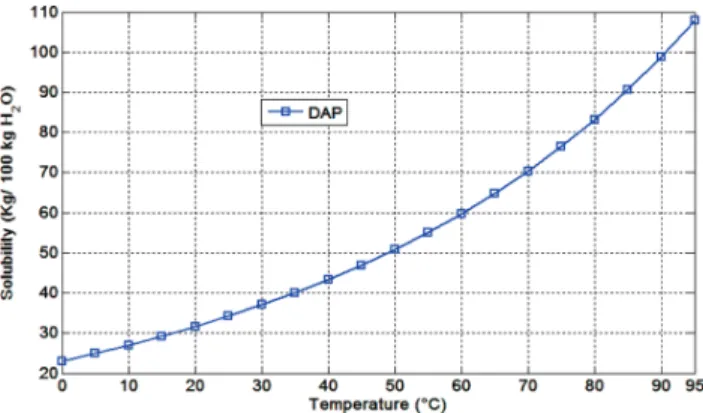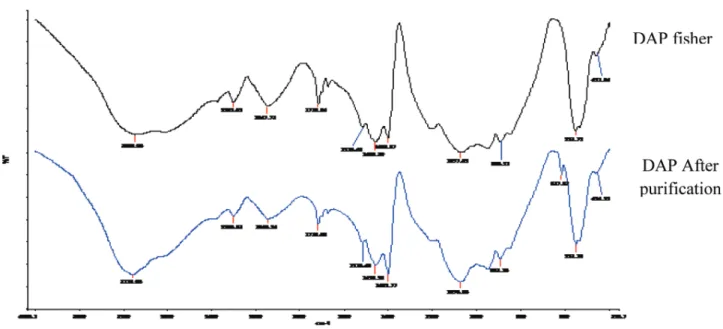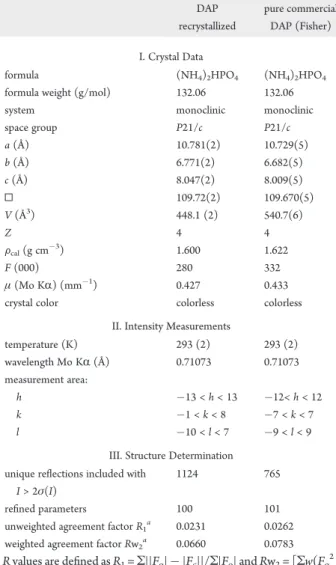HAL Id: hal-01634018
https://hal.archives-ouvertes.fr/hal-01634018
Submitted on 7 Mar 2019
HAL is a multi-disciplinary open access
archive for the deposit and dissemination of
sci-entific research documents, whether they are
pub-lished or not. The documents may come from
teaching and research institutions in France or
abroad, or from public or private research centers.
L’archive ouverte pluridisciplinaire HAL, est
destinée au dépôt et à la diffusion de documents
scientifiques de niveau recherche, publiés ou non,
émanant des établissements d’enseignement et de
recherche français ou étrangers, des laboratoires
publics ou privés.
Synthesis and Physicochemical Characterization of Pure
Diammonium Phosphate from Industrial Fertilizer
M. Gargouri, C. Chtara, P. Charrock, Ange Nzihou, H. El Feki
To cite this version:
M. Gargouri, C. Chtara, P. Charrock, Ange Nzihou, H. El Feki. Synthesis and Physicochemical
Characterization of Pure Diammonium Phosphate from Industrial Fertilizer. Industrial and
engineer-ing chemistry research, American Chemical Society, 2011, 50 (11), p.6580-6584. �10.1021/ie102237n�.
�hal-01634018�
Synthesis and Physicochemical Characterization of Pure
Diammonium Phosphate from Industrial Fertilizer
M. Gargouri,*
,†C. Chtara,
‡P. Charrock,
§A. Nzihou,
^and H. El Feki
††Laboratory of Materials Sciences and Environment, Science University of Sfax, 3010 Sfax, University of Sfax, Tunisia. ‡Chemical Group of Tunisia, Gabes
§LERISM, IUT P.Sabatier, Castres 81104, France
^RAPSODEE, Ecole des Mines d0Albi-Carmaux, campus Jarlard, 81013, Albi, France
ABSTRACT:Diammonium phosphate (DAP) is produced from industrial phosphoric acid that contains large amounts of anionic and cationic impurities (Co, Cu, Fe, Mn, Mo, Ni, Zn, F, As, Al, Hg, Pb and Cd). Consequently all those impurities will be found in DAP. However, the industrial DAP obtained can be used as fertilizers, but cannot be used for some industrial application like pharmaceutics and cosmetics. After purification, the price of DAP is three times more expensive than the same product before purification. The procedure for purification of industrial DAP is a recrystallization, by using several mixtures of solvents. The physicochemical characterization of this fertilizer upstream and downstream from the purification, through spectroscopic analyses and chemical analyses, shows that recrystallization eliminates impurities. Purified DAP was obtained, the physicochemical properties of which are comparable to those of the pure commercial DAP (Fisher).
1. INTRODUCTION
Diammonium phosphate (DAP) is an important commercial fertilizer. The important water-soluble P fertilizers include mono-ammonium phosphate (MAP) and dimono-ammonium phosphate (DAP).1The fertilizer is produced industrially in large quantities via the reaction between gaseous ammonia and green phosphoric acid. The reaction is exothermic; the equation for the neutralization reaction between ammonia and phosphoric acid is as follows:2
2NH3þ H3PO4f ðNH4Þ2HPO4
When the molar ratio (MR) of ammonia to phosphoric acid is 2, DAP is formed.2The phosphoric acid used in producing DAP can be crude unpurified acid obtained by dissolving phosphate rock with sulfuric acid. In this case, crude DAP results, which may be adequate for some applications. However phosphate rock may contain heavy metals and these can be transferred to the fertilizer, and further to crops.
Two options are available to produce purified DAP: (1) use purified phosphoric acid; (2) purify the DAP. For producing industrial purified diammonium phosphate from wet process phosphoric acid, it is necessary to purify the phosphoric acid in advance according to a process of extracting phosphoric acid from wet process phosphoric acid according to a solvent process,
followed by reacting ammonia with the resulting extract to obtain diammonium phosphate containing a small amount of impurities. However, this extraction process cannot be regarded as an industrially advantageous process owing to its complicated steps.3 Our work began with the purification of monoammonium phosphate (MAP) from industrial fertilizer, and the results are very encouraging.4This prompted us to pursue this study on another product of the same family, DAP.
In the present work, we are interested in eliminating impurities from industrial DAP. We present here the physicochemical characterization of DAP fertilizer upstream and downstream of the purification process, with an aim to determine the performance Table 1. Chemical Compositions of the DAP Upstream and
Downstream from the Recrystallization
samples P2O5 (wt) % N (wt)% H2O (wt) % MR (N/P) pH plant DAP 46.05 17.65 1.50 1.94 7.6
plant DAP recrystallized 49 18 1.68 1.86 7.9
of recrystallization. We also compare the recrystallized DAP to the commercial DAP (Fisher).
2. EXPERIMENTAL SECTION
2.1. Recrystallization. Crystallization experiments of DAP (fertilizer synthesized in industry from Tunisia) were carried
between 273 and 400 K and at 400 rpm stirring rate. The suspension was dissolved in mixed solvent (70% water$30% alcohol). After that we add a quantity of charcoal in the solution. The suspension was filtered, and the solution was cooled to 273 K, whereupon crystals appeared. We recrystallized the DAP using a mixture of solvent, water, and alcohol. Impurities were analyzed by inductively coupled plasma-optical emission spectroscopy (ICPOES). Table 2. Determination the Impurity Present in the DAP Upstream and Downstream from the Recrystallizationa
sample (ppm) Fe Al Mg Ag As Co Pb Hg Si Sn Ti Cr Zn Cd Cu Ni Mn V
plant DAP 6769 4273 4907 6 26 5419 22 3 150 382 93 525 1203 34 59 25 65 1341
plant DAP recrystallized (water-alcohol) 24 37 14 - 3 3 7 - 70 - 2 27 41 3 4 17 1 47
commercial DAP (Fisher) 15 22 9 - 3 2 7 - 38 - - 25 11 3 2 17 - 9
aDash (-) = trace.
Figure 2. The analysis by means of IR of the industrial DAP upstream from the recrystallization.
2.2. Analytical and Testing Methods.P2O5content in the solution is determined gravimetrically. The molar rapport of ammonia to phosphoric acid (MR) was obtained by titration with standard 0.5 M NaOH and 0.5 M HCl solutions. The amount of HCl and NaOH added was used to calculate the MR that is equal to 2 (volume of NaOH/volume of HCl), according to the method described in ref 5. A pH Meter was employed to measure the pH values of slurries. N content in the solutions was determined by the Kejdahl method. Melting points were deter-mined with a METTLER FP62 that uses a capillary tube. The curve solubility was determined following a standard procedure described by Mullin.6 IR spectra were determined by a FTIR system spectrum BX Perkin-Elmer spectrometer. The analysis by scanning electron microscope (SEM) is determined with a MEB Philips s!erie XL 30. Data collection is realized by using
KappaCCD Server Software (Nonius, 2004); program(s) used to solve structure are SHELXS97. The spectra of X-ray powder diffraction (XRPD) is determined by a Seifert 3000. T.T. spectrometer.
3. RESULTS AND DISCUSSION
The principal chemical compositions of the DAP upstream and downstream from the recrystallization are presented in Table 1. After purification, the % P2O5and % N were increased while keeping the molar ratio (MR) range between 1.8 and 2.0. Also, after purification the percentage of H2O and value of pH are slightly changed but in the various ranges stated. There is 25% of impurities by weight in the crude industrial DAP.
Diammonium phosphate granules contain various com-pounds (Ca, Mg)(NH4)(Fe, Al)(PO4)(F, OH)H2O that are insoluble in water and can comprise up to 10% of the total P content of fertilizers.7The DAP contains toxic elements such as (Cd, Zn, Cu, and Ni) which are toxic for plants and have the potential for adverse effects on human health due to the transfer of metals from soils to food corps. Thus, it is important to eliminate or reduce these toxic elements in DAP. The analysis of the DAP after purification is given in Table 2 and shows that the quantity of impurity decreases. The results are comparable to those of the commercial DAP (Fisher).
After recrystallization, the melting point was found to be 194 !C, close to the one of laboratory grade DAP (196 !C).
The curve solubility of recrystallized DAP, that was deter-mined following a standard procedure described by Mullin,6is shown in Figure1. The solubility of a solute is most conveniently stated as the parts by weight per part (or 100 parts) by weight of solvent.
The analysis by means of IR of the DAP before and after recrystallization is presented in Figures 2 and 3.
Figure 4. The analysis by MEB of the industrial DAP upstream and downstream from the recrystallization.
Table 3. The Wavelength of the Vibration Mode of DAP Upstream (ur) and Downstream (dr) from the Recrystalliza-tion and Pure Commercial DAP (Fisher)
bands
band limit of
absorption (cm$1)8,9 DAP (ur) DAP (dr)
pure commercial DAP (Fisher) PO43- υ1: 1000$800 954 886 893 υ2: 500$300 531 454 451 υ3: 1200$1000 1097 1076 1077 υ4: 650$500 618 553 553 NH3 ∂a: 1600$1575 1516 1516 1516 ∂s: 1500$1300 1400 1403 1402 NH4þ υNH: 3300$3030 3119 3119 3099 H2O υOH: 3600$3100 3119 3119 3099
The characteristic wavelengths of the vibration modes of DAP are illustrated in Table 3, which shows the presence of the four modes of vibrations ascribed to PO43-observed at about 444, 539, 917, and 1110 cm$1, the vibrations of ammonia observed about 1400 cm$1, and a wide band attributed to H2O and NH4þ stretching modes observed around 3137 cm$1.
In addition, the analysis by sweeping electron microscope (MEB) of the industrial DAP after recrystallization, showed that the elements of aluminum, magnesium, and copper are elimi-nated, and the quantity of sulfur was decreased (Figure 4).
The crystal structure of the recrystallized diammonium phos-phate (NH4)2HPO4has been determined by X-ray single crystal analysis at room temperature. The space group is P21/c10with lattice parameter a = 10.781(2) Å, b = 6.771(2) Å, c = 8.047(2) Å, and Z = 4. The refinement converged to R1= 0.0231 and RW2= 0.0660. The analysis by X-ray diffraction showed that the purification of the DAP did not change the crystalline system (monoclinic). Crystal data details and structure refinement are given in Table 4 and show that the crystallographic parameters of Table 4. Crystal Data Details and Structure Refinement of the Plant DAP Downstream from the Recrystallization and Commercially Pure DAP
DAP recrystallized
pure commercial DAP (Fisher) I. Crystal Data
formula (NH4)2HPO4 (NH4)2HPO4
formula weight (g/mol) 132.06 132.06
system monoclinic monoclinic
space group P21/c P21/c a (Å) 10.781(2) 10.729(5) b (Å) 6.771(2) 6.682(5) c (Å) 8.047(2) 8.009(5) 0 109.72(2) 109.670(5) V (Å3) 448.1 (2) 540.7(6) Z 4 4 Fcal(g cm$3) 1.600 1.622 F (000) 280 332 μ (Mo KR) (mm$1) 0.427 0.433
crystal color colorless colorless
II. Intensity Measurements
temperature (K) 293 (2) 293 (2) wavelength Mo KR (Å) 0.71073 0.71073 measurement area: h $13 < h < 13 $12< h < 12 k $1 < k < 8 $7 < k < 7 l $10 < l < 7 $9 < l < 9
III. Structure Determination unique reflections included with
I > 2σ(I)
1124 765
refined parameters 100 101
unweighted agreement factor R1a 0.0231 0.0262
weighted agreement factor Rw2a 0.0660 0.0783
aR values are defined as R
1= Σ||Fo|$ |Fc||/Σ|Fo|and Rw2= [Σw(Fo2$ Fc2)2/Σw(Fo2)2]1/2where w$1= [σ2(Fo2) þ (0.0442P)2þ 2.4726P] and P = (Fo2þ 2Fc2)/3.
Figure 5. The analysis by XRPD of the industrial DAP.
Figure 6. The analysis by XRPD of the industrial DAP downstream from the recystallization.
recrystallized DAP are close to the pure DAP (Fisher), which justifies the performance of the recrystallization.
In addition, the analysis by X-ray powder of industrial DAP downstream of the purification (Figure 6) shows an elimination of the impurities that were found upstream of the purification (Figure 5), and we got a good crystalline product that resembles the pure commercial DAP (Fisher) (Figure 7).
4. CONCLUSION
The long-continued application of impure DAP can redis-tribute and elevate heavy metal concentrations in soils. The redistribution of heavy metals can adversely affect water re-sources and endanger the health of surrounding ecosystems and human populations. Thus, it is important to eliminate the different toxic elements present in the fertilizer in order to prevent transfer to plants and humans, in this case with the use of purified fertilizers in biological agriculture. On the other hand, you can also use the purified product in the pharmaceutics and cosmetic industries.
After purification, the % P2O5and % N increased, while the molar ratio (MR) remained between 1.8 and 2.00 and the products obtained contained 1.5$2% H2O and had a pH value of 7$8. The analysis by X-ray diffraction showed that the purifica-tion of the plant DAP did not change the crystalline system (monoclinic).
The physicochemical characterization of the industrial DAP downstream of the purification, through spectroscopic analyses and chemical analyses, showed that we obtained purified DAP whose physicochemical properties are comparable with those of the pure commercial DAP (Fisher).
’AUTHOR INFORMATION
Corresponding Author
*E-mail: gargouri1412@yahoo.fr.
’ACKNOWLEDGMENT
The authors thank Dr. A. Driss from the University of Tunis, Tunisia, for his valuable collaboration.
’REFERENCES
(1) Duraisamy, V. P. Role of inorganic and organic soil amendments. Aust. J. Soil Res. 2005.
(2) Campbell, G. R.; Leong, Y. K.; Berndt, C. C.; Liow, J. L. Ammonium phosphate slurry rheology and particle properties The influence of Fe(III) and Al(III) impurities, solid concentration, and degree of neutralization. Ind. Eng. Chem. Res. 2006, 61, 5856–5866.
(3) Akiyama, A. Studies on chemical fertilizers. K.K. Nissin Syuppan 1976.
(4) Gargouri, M.; Chtara, C.; Charock, P.; Nzihou, A.; Elfeki, H. Synthesis and physicochemical characterization of pure monoammo-nium phosphate (MAP) from industrial fertilizer. J. Chem. Chem. Eng. 2010, 49, .
(5) Shengwei, Tang; Hui, Guo; Jiankang, ying; Bin., Liang Physi-colchemical propreties of acidic ammonium phosphate slurries. Ind. Eng. Chem. Res. 2004, 43, 3199.
(6) Mullin, J. Crystallization; Butterworth-Heinemann : Oxford, GB, 2001.
(7) Gilkes, R. J.; Mangano, P. Poorly soluble iron-aluminium phos-phates in ammonium phosphate fertilizers: Their nature and availability to plants. Aust. J. Soil Res. 1983, 21, 183–194.
(8) Nakamoto, K. Infrared and Raman Spectra of Inorganic and Coordination Compounds; Wiley: New York, 1984.
(9) Parker, F. S. Application of IR Spectroscopy in Biochemistry, Biology and Medicine; Hilger, A., Ed.; Plenum Press: New York, 1971.
(10) Khan, A. A.; Roux, J. P.; James, W. J. The crystal structure of diammonium phosphate, (NH4)2HPO4. Acta Crystallogr., Sect. B 1972, 28, 2065–2069.



